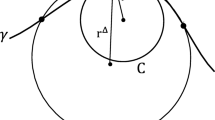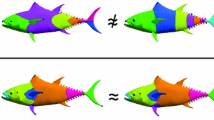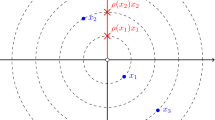Abstract
Geometric invariants play a crucial role in the field of object recognition where the objects of interest are affected by a group of transformations. However, designing robust algorithms that are tolerant to noise and image occlusion remains an open problem. In particular, numerical signature-invariants in terms of joint invariants, as an approximation to the differential signature-invariants, suffer instability, bias, noise and indeterminacy in the resulting signatures. This paper addresses some of these issues in respect of planar signatures. To improve the stability in the Euclidean case, we replace Heron’s formula by the “accurate area” and then we demonstrate that the proposed algorithm is, not only numerically stable but is also, in terms of mean square error, a closer approximation (by at least a factor of three) compared with the original formulation of Calabi. To reduce noise in the resulting curves “the n-difference technique” and “the m-mean signature method” are introduced and we show that these methods are capable of minimizing noise by more than 90 %. The n-difference technique can also be applied to eliminate indeterminacy in the outputs. For the equiaffine case, we improve and extend the required formulation for the implementation of Signature theory for any planar meshes with a general position property. Moreover, we introduce a general formulation for the full conic sections to determine an equiaffine-invariant numerical approximation to the equiaffine arc length, measured along the given curve between any two points of the mesh. Finally, we demonstrate the discriminative power of the concept of discrete signature analysis for distinguishing normal and abnormal regions in the medical imaging domain.










Similar content being viewed by others
References
Halphen, M.: Sure les invariants différentiels des courbes gauches. J. Éc. Polytech. 28(1) (1880)
Wilczynski, E.J.: Projective Differential Geometry of Curves and Ruled Surfaces. Teubner, Leipzig (1906)
Wilczynski, E.J.: Projective differential geometry of curved surface (second memoir). Trans. Am. Math. Soc. 9(1), 79–120 (1908)
Čech, E., Fubini, G.: Geometria Proiettiva Differenziale. Zanichelli, Bologna (1927)
Weyl, H.: The Classical Group. Princeton University Press, Princeton (1939)
Cartan, É.: La Méthode du Repére Mobile, la Théorie des Groupes Continus et les Espaces Généralisés. Exposés de Géométrie, vol. 5. Hermann, Paris (1935)
Nagata, M.: Complete reducibility of rational representations of a matric group. J. Math. Kyoto Univ. 1(1), 87–99 (1961)
Mumford, D., Fogarty, J., Kirwan, F.: Geometric Invariant Theory, 3rd. edn. Ergebnisse der Math., vol. 34. Springer, Berlin (1994). (the 1st edition published in 1965, is the “Bible” on the subject)
Weiss, I.: Geometric invariants and object recognition. Int. J. Comput. Vis. 10(3), 207–231 (1993)
Faugeras, O.: Cartan’s moving frame method and its application to the geometry and evolution of curves in the Euclidean, affine and projective planes. In: Applications of Invariance in Computer Vision. Lecture Notes in Computer Science, vol. 825, pp. 11–16. Springer, Berlin (1994)
Calabi, E., Olver, P.J., Shakiban, C., Tannenbaum, A., Haker, S.: Affine geometry, curve flows and invariant numerical approximations. Adv. Math. 124(1), 154–196 (1996)
Calabi, E., Olver, P.J., Shakiban, C., Tannenbaum, A., Haker, S.: Differential and numerically invariant signature curves applied to object recognition. Int. J. Comput. Vis. 26, 107–135 (1998)
Bruckstein, A.M., Halt, R.J., Netravali, A.N., Richardson, T.J.: Invariant signatures for planar shape recognition under partial occlusion. CVGIP, Image Underst. 58, 49–65 (1993)
Rathi, Y., Olver, P.J., Sapiro, G., Tannenbaum, A.R.: In: Affine Invariant Surface Evolutions for 3D Image Segmentation. Dougherty, E.R., Nasrabadi, N.M., Rizvi, S.A. (eds.): Image Processing: Algorithms and Systems, Neural Network, and Machine Learning, vol. 6064, p. 606401. SPIE, Bellingham (2006). Proc. Of SPIE-IS&T Electronic Imaging
Olver, P.J.: Invariant submanifold flows. J. Phys. A, Math. Theor. 41(34), 344017 (2008)
Olver, P.J.: Joint invariant signatures. Found. Comput. Math. 1(1), 3–68 (2001)
Olver, P.J.: Classical Invariant Theory. Cambridge University Press, New York (1999)
Musso, E., Nicolodi, L.: Invariant signature of closed planar curves. J. Math. Imaging Vis. 35, 68–85 (2009)
Feng, S., Kogan, I., Krim, H.: Classification of curves in 2D and 3D via affine integral signatures. Acta Appl. Math. 109(3), 903–937 (2010)
Hoff, D., Olver, P.J.: Extensions of invariant signatures for object recognition. J. Math. Imaging Vis. 45, 176–185 (2013)
Hoff, D.: Automatic solution of jigsaw puzzles. University of Minnesota (2011, preprint). http://www.math.umn.edu/~olver/paper.html
Boutin, M.: Numerically invariant signature curves. Int. J. Comput. Vis. 40(3), 235–248 (2000)
Friedman, M., Kandel, A.: Fundamentals of Computer Numerical Analysis. CRC Press, Boca Raton (1993)
Kahan, W.: Miscalculating area and angles of a needle-like triangle. Lecture notes (2000). cs.berkeley.edu/~wkahan/Triangle.pdf
Dehmeshki, J., Amin, H., Dehkord, M.E., Jouannic, A., Qanadli, S.: Computer aided detection and measurement of abdominal aortic aneurysm using computed tomography digital images. In: 3rd International Conference on Digital Society, ICD, Cancun, Mexico. doi:10.1109/ICDS.2009.65 (2009)
Acknowledgement
We would like to thank Peter J Olver for his advice and comments.
Author information
Authors and Affiliations
Corresponding author
Rights and permissions
About this article
Cite this article
Aghayan, R., Ellis, T. & Dehmeshki, J. Planar Numerical Signature Theory Applied to Object Recognition. J Math Imaging Vis 48, 583–605 (2014). https://doi.org/10.1007/s10851-013-0427-6
Published:
Issue Date:
DOI: https://doi.org/10.1007/s10851-013-0427-6




